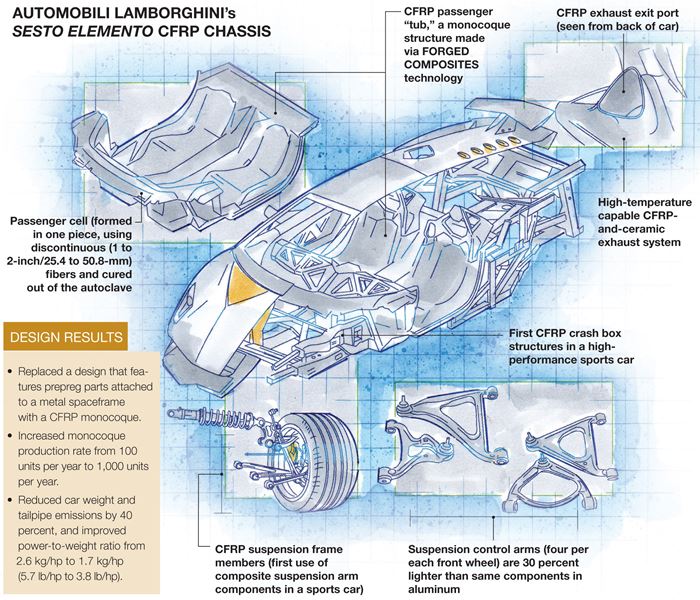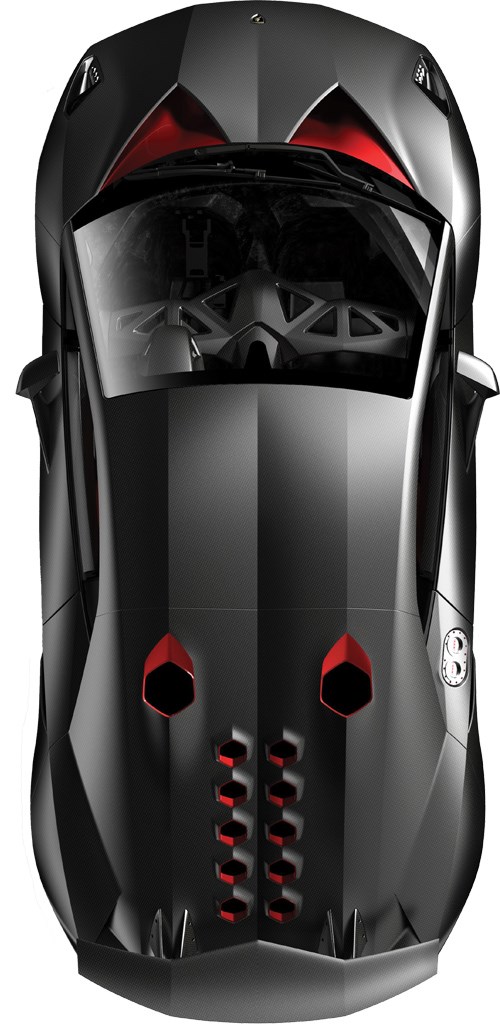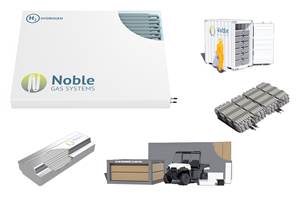Sixth Element: Lamborghini accelerates CFRP
The automaker’s R&D centers in Italy and the U.S. implement aerospace-inspired design philosophy to radically enhance the use — and the benefits — of CFRP.
Design Results:
• Replaced a design that features prepreg parts attached to a metal spaceframe with a CFRP monocoque.
• Increased monocoque production rate from 100 units per year to 1,000 units per year.
• Reduced car weight and tailpipe emissions by 40 percent, and improved power-to-weight ratio from 2.6 kg/hp to 1.7 kg/hp (5.7 lb/hp to 3.8 lb/hp).
Although Automobili Lamborghini SpA (Sant’Agata Bolognese, Italy) has used carbon fiber-reinforced polymer (CFRP) in all of its production sports cars since 1990, the automaker has radically changed its design and production in the past five years, evolving from autoclave-cured prepreg parts attached to a metal spaceframe to an out-of-autoclave CFRP monocoque (integrated chassis/structural body).
Lamborghini’s new approach was propelled by a new emphasis on acceleration and handling vs. top speed. The traditional approach to the latter has been to add horsepower, but that increases emissions and does not necessarily improve acceleration, which depends on the power-to-weight ratio. Acknowledging that the average weight of its models had increased 500 kg/1,102 lb due to improvements that increase safety and comfort and reduce emissions, Lamborghini focused on CFRP. As CEO Stephan Winkelman explains, “Every new Lamborghini will make the best use of carbon fiber to reduce weight.” But how would that “best use” be determined?
The Automobili Lamborghini Advanced Composite Structures Laboratory (ACSL) was established for that purpose in 2007 at the University of Washington (Seattle, Wash.). It works closely with Lamborghini’s Advanced Composites Research Center (ACRC) in Sant’Agata Bolognese, and is funded in part by The Boeing Co. (Chicago, Ill.), for which ACSL director Dr. Paolo Feraboli previously worked, and the U.S. Federal Aviation Admin. (Washington, D.C.). “There is a lot of opportunity for exchange between the aviation and automotive industries in these areas,” Feraboli explains. So when Lamborghini’s senior VP and chief technical officer, Maurizio Reggiani, challenged the ACSL and ACRC to dramatically reduce the weight and cost of new models, yet preserve their performance and safety, Feraboli and his team, based on lessons learned on Boeing’s 787, suggested moving away from prepreg and adopting aerospace-derived design methodologies to achieve very high-performance CFRP structures out of the autoclave.
Next-generation design
The first fruit was the Aventador, unveiled in March 2011. When its development began in October 2007, Lamborghini’s goal was to follow the successful V-12 Murciélago with a lighter, better-performing vehicle that could be produced in greater numbers — at least 1,000 Aventadors per year, compared to 500 Murciélagos per year. “These volumes simply aren’t practical using a traditional prepreg approach,” explains Feraboli.
Inspired by Formula 1 race car design, ACSL and ACRC first proved out a CFRP monocoque, which integrates the vehicle’s load-bearing structure and occupant cell. It functions like a roll cage and reduces weight by cutting the number of parts. The monocoque was refined as the now-patented resin transfer molding process, RTM-Lambo, was developed. Based on RTM Lite, its low injection pressure enables the use of less-expensive equipment and composite tooling in place of costly matched metal molds. ARALDITE epoxy RTM resin, from Huntsman Advanced Materials (Basel, Switzerland), is reinforced with dry stitched fabric. Braided fabric adds torsional stiffness in tubular components, such as structural roof pillars and door sills. Epoxy foam between the CFRP layers increases stiffness and damps noise and vibration at strategic points. Aluminum inserts were designed into the laminate at front and rear aluminum subframe attachment points.
“Because we used higher performance materials, we did not need ribs to stiffen the tub structure, making it simpler to produce,” Feraboli points out. “We achieved an RTM cycle time of several hours, with the total monocoque completed in 10 to 20 hours.” Attilio Masini, ACRC’s head of materials and manufacturing processes, says the OOA process has increased monocoque production from two per week to more than five per day, reducing cost by a factor of 10.
The Aventador’s monocoque weighs only 147.5 kg/325 lb and helps it attain a top speed of 350 kmh/218 mph. The car accelerates from 0 to 100 kmh (62 mph) in 2.9 seconds (Murciélago reached 330 kmh, and 0 to 100 kmh in 3.6 seconds) yet the fuel consumption and CO2 emissions are down by about 20 percent. The car also set a new record for Lamborghini: 1,400 were sold the first month after its release.
The Sixth Element
Lamborghini’s next step was the Sesto Elemento (Italian for “sixth element,” named for the placement of carbon on the periodic chart). Unveiled in October 2010, before the Aventador, the Sesto Elemento was a later project, but it required less time because it is a technology demonstrator. Feraboli recalls, “Mr. Reggiani’s idea with the Sesto Elemento was to take the same powertrain as in the Gallardo Superleggera and reduce the [overall] weight from 1,340 kg to 999 kg [2,954 lb to 2,202 lb], realizing 650 kg [1,433 lb] of that is in the V-10 engine alone.” The lightest production Lamborghini ever made, the Superleggera can go from 0 to 100 kmh in 3.4 seconds. So how do you improve on that? “Eighty percent of the Sesto Elemento is carbon fiber,” answers Feraboli. (By contrast, the Murciélago’s CFRP content by weight is 30 percent, and the Aventador’s is 50 percent. Lamborghini forecasts that its annual CFRP use will triple, rising to 300 metric tonnes — nearly 661,390 lb — by 2013.)
The car uses CFRP not only in its monocoque, but also in its suspension (the control arms are 30 percent lighter than in aluminum), transmission shaft (the central joint was eliminated), front subframe and crash boxes. Further, its entire exhaust system is made of high-temperature CFRP and ceramic materials. The Sesto Elemento’s CFRP suspension and an all-CFRP front crash box are “firsts”: “CFRP has never been used in sports car suspensions before, and manufacturers have always used aluminum and/or steel in the crash boxes, even if they did use some CFRP,” says Feraboli.
Featuring a skin one-third the thickness of previous CFRP sports car body panels, the Sesto Elemento’s monocoque achieves the required rigidity via Boeing 787-inspired integrated stiffeners. It also uses one-shot FORGED COMPOSITES technology, developed in collaboration with Callaway Golf Co. (Carlsbad, Calif.) and proven out at ACSL. Instead of continuous woven fibers, FORGED COMPOSITES uses 1- to 2-inch (25- to 51-mm) long cut fibers, quickly molded out of autoclave. Lamborghini’s take on this technology, patented as RADICARBON, claims more than 50,000 intertwined fibers per square inch and greater strength and stiffness by weight than aluminum. Feraboli says the technology’s matched metal molds, heated presses and pressure (>1,000 psi) mint composites that replace aluminum forgings, one to one. “It enables a ... complex structure not possible with traditional unitape.”
Quantum Composites’ (Bay City, Mich.) AMC 8500 family of products is used, featuring vinyl ester resin and chopped 12K carbon fiber. “Because it is lower performance than UD tape,” explains Feraboli, “you must re-engineer the structure to get the necessary stiffness- and strength-to-weight ratio to replace aluminum. You can do this somewhat with shape — section modulus — but also by using UD selectively in combination with discontinuous fiber.”
Feraboli’s goal is not only to completely eliminate the autoclave (the Aventador still requires an autoclave cycle for exterior prepreg surfaces) but also to reduce press cycle times to four minutes for vinyl ester and 10 minutes for epoxy. This will be necessary in a future production model that replaces the Gallardo series, production of which reached almost 2,000 cars in 2008. Feraboli contends that FORGED COMPOSITES can mint 10,000 parts per year.
The Sesto Elemento has achieved its designers’ objectives. “We reduced the weight and emissions by 40 percent — weight and emissions are directly proportional — and cut acceleration from 0 to 100 kmh down to 2.5 seconds, without a new powertrain,” says ACRC director Luciano DeOto. By comparison, the designers of the Bugatti Veyron added 1,000 hp to do the same.
“We have increased the power-to-weight ratio, and the customer’s experience of the car’s handling and performance has improved dramatically,” Feraboli adds. Although Lamborghini says RADICARBON isn’t ready for serial production, Feraboli notes, “We have been working with Boeing for six years to develop suitable analysis methods for modeling this material’s behavior in structures, which is very different from traditional composites. Combined with the ACRC’s work, we are very close to production capability now.”
Driving into the future
Lamborghini, in fact, claims it is the only automaker to have mastered the complete CFRP design-to-production process in-house. Based on aerospace best practices, its monocoques are made to tolerances of ±0.1 mm/±0.004 inch. Boeing’s “building-block” approach to testing and design allowables development reportedly enabled the Aventador to pass its crash test certification on its first try. “Each crash test costs over $1 million, so it is very good to get it right the first time,” quips Feraboli. “This enables us to perform virtual tests on Lamborghinis we develop in the future.”
So what is the impact? According to Feraboli, higher performance and less expensive, more optimized R&D.
Related Content
Noble Gas Systems 350-bar conformable pressure vessels pass HGV2 standard tests
Conformable tanks with new materials pass technical tests for hydrogen storage, to compete with Type IV pressure vessels using CFRP.
Read MoreCo-molding SMC with braided glass fiber demonstrates truck bed potential
Prepreg co-molding compound by IDI Composites International and A&P Technology enables new geometries and levels of strength and resiliency for automotive, mobility.
Read MoreCorebon, Composite Braiding partner to enhance TPC manufacturing
Collaboration aims to overcome production limitations with tubular thermoplastic composites (TPC) by using induction-heated tooling and high-quality commingled braids.
Read MoreRead Next
All-recycled, needle-punched nonwoven CFRP slashes carbon footprint of Formula 2 seat
Dallara and Tenowo collaborate to produce a race-ready Formula 2 seat using recycled carbon fiber, reducing CO2 emissions by 97.5% compared to virgin materials.
Read More“Structured air” TPS safeguards composite structures
Powered by an 85% air/15% pure polyimide aerogel, Blueshift’s novel material system protects structures during transient thermal events from -200°C to beyond 2400°C for rockets, battery boxes and more.
Read MoreVIDEO: High-volume processing for fiberglass components
Cannon Ergos, a company specializing in high-ton presses and equipment for composites fabrication and plastics processing, displayed automotive and industrial components at CAMX 2024.
Read More































